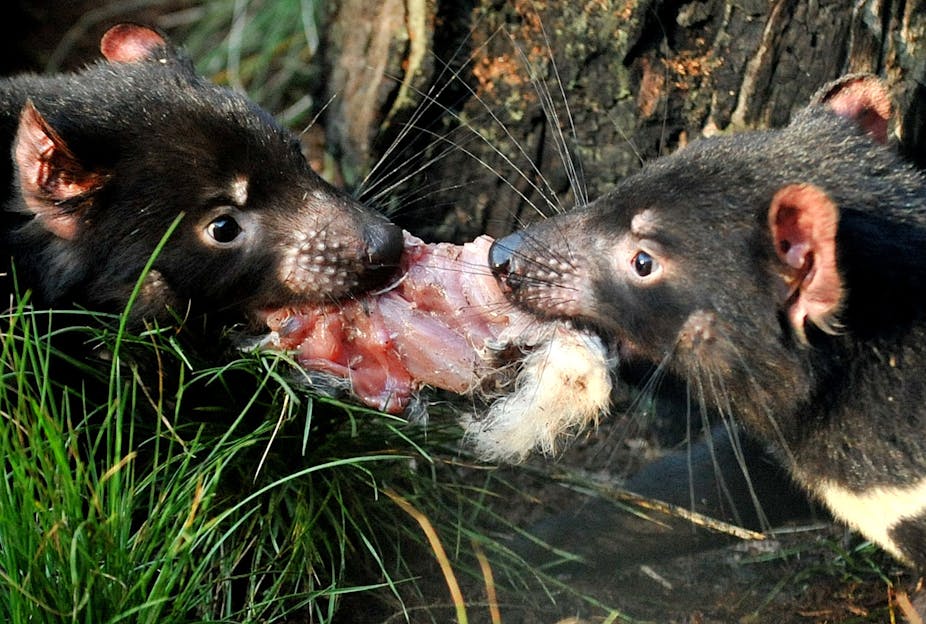For more than a decade, the Tasmanian devil has been fighting for survival against an unusual enemy – Devil Facial Tumour Disease (or DFTD). This deadly infectious cancer has ravaged the Tasmanian devil population to the point where the species is now endangered.
Other cancers are the victim’s own cells gone crazy, but DFTD is someone else’s cells gone crazy: the tumour cells are genetically different from the host and are all clonal descendants of a single tumour from one long-dead devil.
Scientists now generally agree that the disease is likely to cause the extinction of the devil if nothing is done. At the current rate of disease spread, the devil could be extinct on the Tasmanian mainland in as little as 25 years.
DFTD spreads when devils bite one another. During biting, tumour cells are transferred directly from one devil to another, and once implanted, multiply rapidly. They are not rejected by the recipient’s immune system because the devil population is so genetically uniform that the tumour cells are not seen as “non-self”.
Biting is a part of daily life for devils – during fights over food, and even while mating. This has meant that the disease has spread rapidly across the state. Once a devil has become infected, a protracted and painful death is assured.
What can be done to prevent devils becoming extinct? One obvious approach is to remove diseased animals from affected populations. If enough could be removed sufficiently rapidly, then the disease could be eliminated.
Between 2004 and 2010, all infected devils that could be caught in quarterly trapping trips were removed from the isolated Forestier Peninsula, near Port Arthur. Despite some initially promising signs, the progress of the epidemic was not slowed.
As a result, the trial was ended in 2010.
We used mathematical modelling techniques to see whether different strategies – such as more frequent or more intensive trapping – could have made this approach work.
Our modelling suggested that almost all of the infectious devils (around 96%) would need to be removed on a regular basis to stop the disease.

Unfortunately, this is not possible: many devils, for one reason or another, don’t enter traps. Furthermore, after infection, the tumours take time to grow and become detectable (the current best estimate is around six months).
These devils with latent disease are ticking disease time bombs – even when we’ve got all the obviously infected ones, the population still isn’t safe. Until we have some way of helping boost the odds in our favour – perhaps with a test capable of detecting infected animals before they become infectious – culling just isn’t going to work.
There is, however, reason for hope. Scientists from a staggering range of fields are working hard to learn more about the devil and its disease.
In the fight against DFTD, knowledge is power. Knowledge about how the disease tricks the devil’s immune system may help researchers to develop a vaccine. Knowledge about the devil’s genetics may uncover disease-resistant devils, which could then be selectively bred. Knowledge about how the devil fits into the wider ecosystem could help uncover ways to help the devil in its own fight against the disease.
The disease is now entering the north-west of Tasmania, where devil populations are subtly different genetically from those in eastern Tasmania, where the disease first arose. We have indications the disease is increasing much more slowly in these Western populations and is having less effect on devil populations.
This means there may be some genetically resistant animals in these populations. If so, not only might these populations be able to resist disease, but we also might be able to introduce resistant western genotypes into the diminished eastern populations.
Alternatively, the disease itself may have evolved to become less pathogenic. How these processes of natural selection are operating on both the devil and the tumour is an area of current research.
In the meantime, establishing disease-free insurance populations of devils is a vital part of the project. These provide a last resort against the horrifying possibility of losing the devil as a species entirely.
There is already a very successful captive breeding program with more than 490 disease-free devils in more than 20 institutions both on the Australian mainland and in Tasmania.
Establishing free ranging disease-free wild populations, either on offshore islands, in fenced off peninsulas in Tasmania, or in large fenced enclosures on the Australian mainland is currently being investigated.

